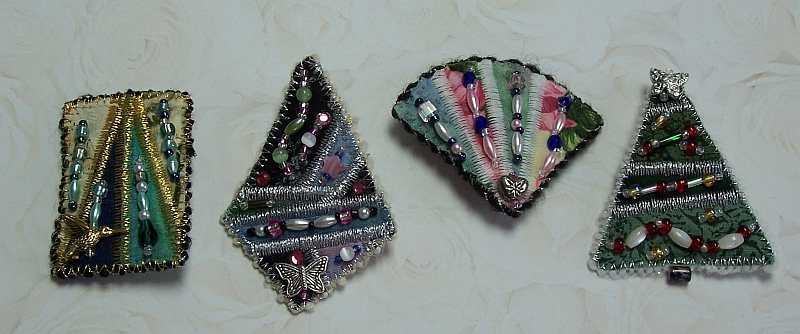Information and Supply List for Mini Art Quilt PinWorkshop:

This is a 3 hour workshop. During this workshop, you will learn how to create my Mini Art Quilt Pins. We will explore one of my unusual construction techniques to make the quilted bases of the pins. You will think of sandwiches in a whole new way after this. Once you have stitched the bases for your pins, I will show you how to add various beads to embellish your one-of-a-kind pins.
This workshop shows you a way to use up some of those small fabric and batting scraps to make beautiful pins to wear or give as gifts. Materials fee includes fusible web, beads, fibers, and hardware enough to make at least 3 pins. Extra kits will be available. Materials fee- $10.00
Supply List:
Paper and pen or pencil for notes.
Zig-Zag sewing machine- cleaned and in good working order, satin stitch or regular presser foot, extra needles, manual, cords and pedal.
Extension cord, power strip
Rotary cutter and small mat with small ruler. A 6" square ruler is big enough.
Assorted threads- Metallics are great, black gives a stained glass look.
Hand sewing needle- #10 sharps or other fine needle. Needle threader- optional.
Small sewing scissors.
Scrap fabric pieces- An assortment of solids and prints in coordinating or contrasting colors, lights, mediums and darks. Minimum size- 1"x2" each, charm squares or strip ends work well. At least 6 to 12 different fabrics will give a good assortment to play with.
Scrap pieces of batting- My favorite is Pellon Thermolam polyester batting, but Warm N Natural or simlar batting works well, too. I also have used Polyfil Traditional. Bring what you have left over from other projects. I will also have some extra if needed.
pressing cloth- a 12" square or larger of cotton muslin.
Fray Check if you have it- I will have some available for workshop use.
Iron and ironing board- at least one per 4 students, or small Clover Iron and ironing pad for personal use- these get hot enough for fusibles, but use less wattage for fewer electrical problems.
Room Requirements:
Room with adequate electrical service for a number of irons.
Access to electrical panel in case of tripped breakers due to Iron usage.
2 tables at front or side of room for teaching and displaying examples.
Minimum of ½ banquet table of space for each student.